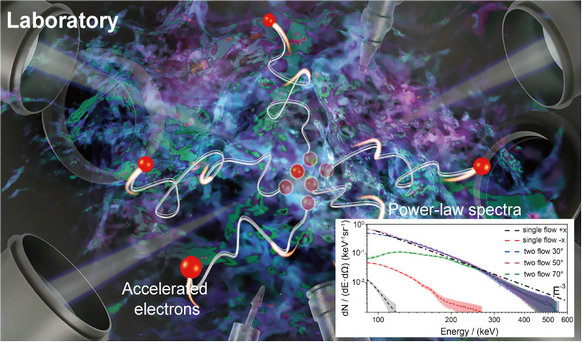Revealing Mystery of High-Energy Electron Origination With Intense Lasers
As one of 125 scientific questions published by Science, the origin of energetic particles in the universe has been puzzling astrophysicists over the years.
A new study led by Prof. ZHAO Gang and Dr. YUAN Dawei from the National Astronomical Observatories of the Chinese Academy of Sciences (NAOC) provides a fresh understanding of how energetic electrons are accelerated in turbulences.
This study was published in Nature Communications on July 13.
The researchers studied the electron acceleration in kinetic turbulent plasmas in a laboratory setting at Shenguang-II (SG-II) laser facility, consisting of eight driven laserbeams.
"Laboratory astrophysics, exploring aspects phenomena with intense laser, gets deeper insights into the astrophysical problems," said Prof. ZHAO Gang, who is the co-corresponding author of this study.
"Our study reveals that the electrons can gain energy from the turbulences through stochastic acceleration mechanism," said ZHAO.
"Kinetic turbulences, meaning that Coulomb collision can be ignored, have been observed in various astrophysical environments. One challenge in the study is how to produce collision-free turbulences in laboratory," said Dr. YUAN Dawei, the first author of this study.
In the lab setting, researches firstly generate kinetic turbulent plasmas through the development of nonlinear Weibel instability. Interestingly, they have also observed accelerated electrons with power-law spectra from different observation angles.
Supported by particle-in-cell simulations, electrons gain energy through the collisions with magnetic island-like structures. The overall process manifests a stochastic acceleration, where the magnetic islands generated in turbulence serve as scattering bodies.
"The process of acceleration can be likened to a game of Ping-pong, where the electron acts as the ball and the magnetic island-like structures serve as the bats. Each time the ball touches the bat, its trajectory is changed, resulting in acceleration." said YUAN.
The findings shed light on a critical transition period during supernova explosion, where kinetic turbulences originating from Weibel instability arise before the formation of collisionless shock. This indicates that electrons experience stochastic acceleration during this transition phase.
This study will also enhance our comprehension of particle acceleration and radiation in complex astrophysical environments.

Image: Artist's illustration of the electron stochastic acceleration in turbulence. The inset of power-law spectra is obtained in laboratory. (Credit: NAOC)
This research result is available at https://www.nature.com/articles/s41467-024-50085-7
Media Contact:
Prof. XU Ang
Email: annxu@nao.cas.cn
Web: http://english.nao.cas.cn